Fitness 101 - The Basics
- mmoses93
- May 8, 2019
- 4 min read
Updated: Apr 17, 2020

Creating a fitness plan that incorporates each of these elements can help ensure that you get the most health benefits from your routine.
Physical fitness can be classified into 5 components including Cardiovascular Fitness, Muscular Strength, Muscular Endurance, Flexibility and Body Composition.

By performing a variety of exercise formats, it is easy to maintain a balanced workout regimen.
Check out the 5 components of fitness below and what type of training you need to do in order to to target each type.

1. Cardiovascular Fitness – The ability of the heart, lungs and vascular system to deliver oxygen-rich blood to working muscles during sustained physical activity. The key is consistency - 150 minutes per week, breaks down to just 15 to 30 minutes of exercise per day, five days a week, depending on how hard you push yourself.
2. Muscular Strength – The amount of force a muscle or muscle group can exert against a heavy resistance. Muscular strength is muscle group-specific meaning, you may have incredibly strong glutes, but comparatively weak deltoids; or incredibly strong pectoral muscles, but comparatively weak hamstrings. This is why a well-balanced strength training program that targets all of your major muscle groups is so important.
Consider Your Goals
The extent to which you train for strength is, again, determined by your own health and fitness goals. For instance, if your focus is on health, you know you should be strong enough to lift a heavy box or to easily stand up from a chair. If, however, you want to develop muscle mass or to be able to lift heavier weights at the gym, your training regimen should be focused more on lifting heavy weights.
3. Muscular Endurance – When a muscle or muscle group repeats a movement many times or you hold a particular position for an extended period of time.
Again the extent to which you choose to focus on muscular endurance should be directly related to your goals and like muscular endurance, muscular strength is muscle group-specific. This means you can develop high levels of endurance in some muscle groups (like cyclists building endurance in their legs) without necessarily developing the same level of endurance in other muscle groups, depending on your needs.
For Everyday Health
For general health purposes, you may want to develop enough endurance to simply climb up several flights of stairs or to lift and carry groceries from your car to your house. Low-intensity weight-bearing or strength-training workouts will help you build up that endurance.
For Fitness-Related Goals
If you want to become an endurance athlete capable of competing in sports that require continual muscle contraction (ie. obstacle course races CrossFit, cycling), you may want to place a higher focus on training high-repetitions and sport-specific activity.
It's possible to improve muscular strength and endurance at the same time!
This can be done in conjunction with cardiovascular training. Circuit Training Routines are awesome for combining strength exercises and cardio into a single bout of training AND it can make your exercise program more efficient.

4. Flexibility – Focuses on the ability of a joint to move through its full range of motion, from a flexed to an extended position.
Yoga and Pilates classes are great methods used to improve flexibility. physical activity guidelines call for adults to engage in flexibility exercises at least two or three days each week.
Flexibility is important at any age and while completely stopping the aging process isn't possible, protecting your joints and maintaining mobility can help keep you spry well into your later years.
5. Body Composition – This includes the amount of fat in the body compared to the amount of lean mass (muscle, bones etc.). This is the component that we are looking to reduce with weight loss goals.
To see improvements in body composition, you need to know what your starting point is.
Weighing yourself on a scale won't do the trick, as weight alone tells you nothing about the makeup of your internal tissues.
Instead, talk to a trainer about having your body fat percentage tested, or consider purchasing a scale that uses bioelectrical impedance analysis (BIA) to estimate body fat percentage. You can also take your own measurements and plug them into a body fat percentage calculator.
With the 4 aforementioned components combined, this fifth component should promote muscular gains and improve cardiovascular fitness, leading to weight loss. Using the FITT Formula (Frequency, Intensity, Type of Exercise, Time/Duration) you can be sure to plan out the most effective exercise program for your goals.

If you have questions about workouts and how to make sure you are using the right training for your goals, feel free to contact me:).
Interested in a fitness/wellness consultation or have some questions about nutrition and your current fitness program? Join any of my groups online (Facebook) and/or pick up my book, How to be Fit for Life - Eight Proven Steps to Reaching Your Fitness Goals, Getting Results, and Living the Fitness Life for more help with your fitness journey. And please feel free to contact me and I'd be happy to answer any questions you may have:).













Comments